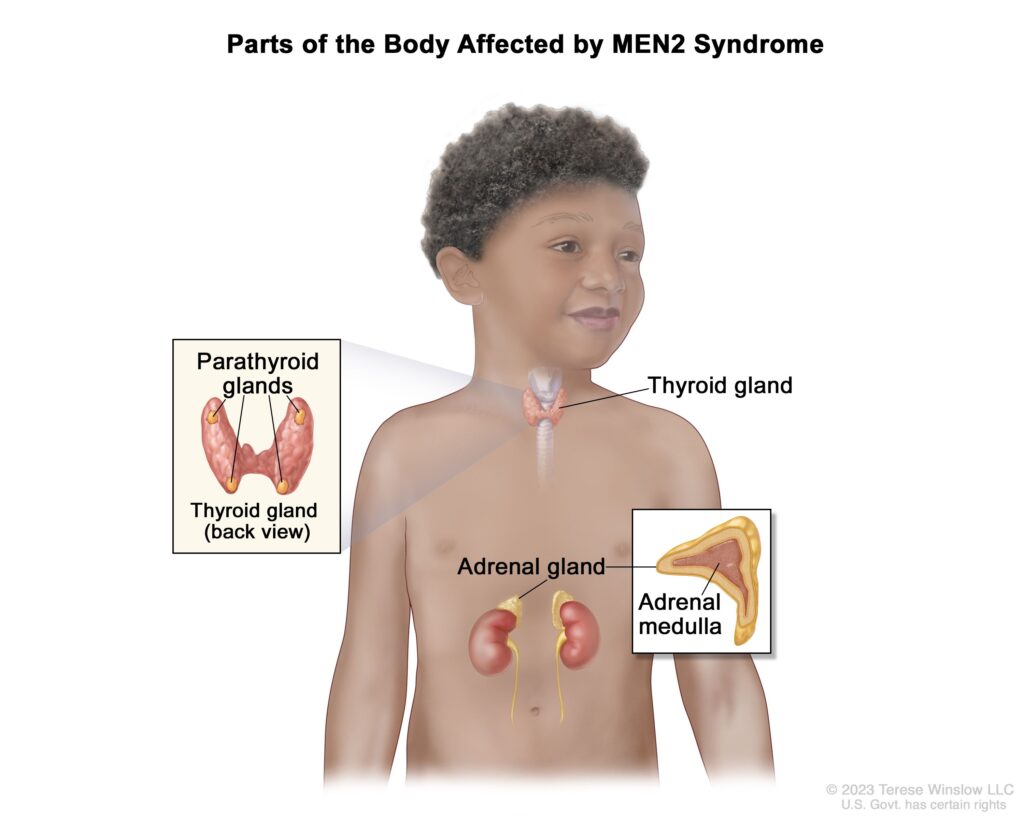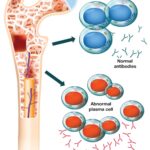Multiple Endocrine Neoplasia (MEN) is a rare genetic disorder characterized by the development of tumors in multiple endocrine glands. These tumors can be benign or malignant and often lead to excessive hormone production, causing various physiological complications. MEN is primarily divided into two major types: MEN1 and MEN2, each with distinct clinical manifestations.

Causes and Genetic Basis of MEN
MEN is caused by inherited genetic mutations that lead to uncontrolled cell growth in endocrine glands. The two major types are:
- MEN1: Caused by mutations in the MEN1 gene, which encodes the tumor suppressor protein menin.
- MEN2: Caused by mutations in the RET proto-oncogene, leading to excessive cell proliferation.
Since MEN is a hereditary disorder, individuals with a family history are at a significantly higher risk of developing the condition.
Types and Associated Endocrine Tumors
1. MEN Type 1 (MEN1)
MEN1, also known as Wermer syndrome, typically affects the following glands:
- Parathyroid glands: Hyperparathyroidism due to parathyroid adenomas leads to excess calcium in the blood.
- Pancreatic islet cells: Tumors such as insulinomas and gastrinomas can cause hypoglycemia or Zollinger-Ellison syndrome.
- Pituitary gland: Tumors may cause overproduction of prolactin (prolactinoma) or growth hormone (acromegaly).
2. MEN Type 2 (MEN2)
MEN2 is divided into MEN2A, MEN2B, and Familial Medullary Thyroid Cancer (FMTC):
- MEN2A: Characterized by medullary thyroid carcinoma (MTC), pheochromocytomas, and parathyroid hyperplasia.
- MEN2B: More aggressive than MEN2A, associated with MTC, pheochromocytomas, and distinctive marfanoid features.
- FMTC: A subtype of MEN2 in which MTC is the predominant feature without other endocrine abnormalities.
Symptoms of Multiple Endocrine Neoplasia
The symptoms of MEN vary depending on the affected glands and hormone imbalances.
Common Symptoms of MEN1:
- Fatigue, kidney stones, and bone pain (due to hyperparathyroidism)
- Abdominal pain and ulcers (gastrinomas leading to excess stomach acid)
- Weight changes, diabetes-like symptoms (insulinomas affecting glucose levels)
- Vision disturbances and headaches (pituitary tumors affecting optic nerves)
Common Symptoms of MEN2:
- Neck lumps and difficulty swallowing (due to medullary thyroid carcinoma)
- Severe hypertension and palpitations (pheochromocytoma-related adrenaline spikes)
- Chronic diarrhea and flushing (hormonal imbalances from endocrine tumors)
- Distinct facial and body features in MEN2B (marfanoid appearance, mucosal neuromas)
Diagnosis of Multiple Endocrine Neoplasia
A combination of clinical assessment, genetic testing, and imaging techniques helps confirm MEN.
1. Genetic Testing
- MEN1 mutation analysis for MEN1 diagnosis.
- RET proto-oncogene screening for MEN2 detection.
2. Biochemical Tests
- Parathyroid hormone (PTH) levels to assess hyperparathyroidism.
- Calcitonin levels for early detection of medullary thyroid cancer.
- Plasma metanephrines to identify pheochromocytoma.
3. Imaging and Scans
- MRI and CT scans to detect tumors in endocrine glands.
- Ultrasound-guided biopsy for thyroid nodules.
Treatment Approaches for MEN
Treatment focuses on tumor removal, managing hormone levels, and genetic counseling.
1. Surgical Intervention
- Parathyroidectomy for hyperparathyroidism in MEN1.
- Total thyroidectomy in MEN2 to prevent medullary thyroid carcinoma.
- Adrenalectomy for pheochromocytomas in MEN2.
2. Medications and Hormone Therapy
- Proton pump inhibitors (PPIs) to manage gastrinomas in MEN1.
- Alpha-blockers to control hypertension from pheochromocytoma.
- Somatostatin analogs to suppress excess hormone production.
3. Targeted Therapies
- Tyrosine kinase inhibitors (TKIs) like vandetanib and cabozantinib for advanced MTC in MEN2.
- Everolimus for pancreatic neuroendocrine tumors.
Prognosis and Long-Term Outlook
- Early genetic screening allows preventive measures and timely interventions.
- Regular monitoring is essential to detect new tumors before complications arise.
- Surgical removal of high-risk tumors significantly improves survival.
Advances in MEN Research
Ongoing research focuses on:
- Gene therapy approaches to correct MEN1 and RET mutations.
- New targeted treatments for MEN-related tumors.
- Artificial intelligence (AI) in early MEN diagnosis.
Multiple Endocrine Neoplasia is a genetic disorder requiring early diagnosis and lifelong management. Advances in genetic screening, targeted therapies, and surgical techniques offer hope for improved outcomes. Patients with a family history of MEN should undergo regular screenings for early detection and treatment planning.

